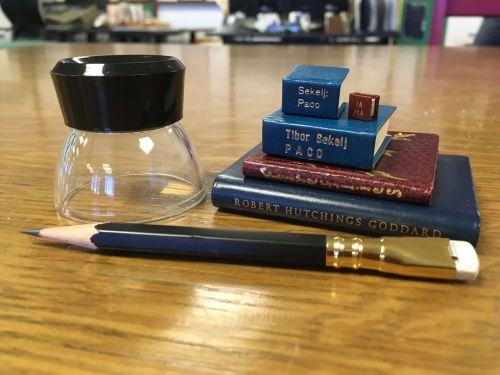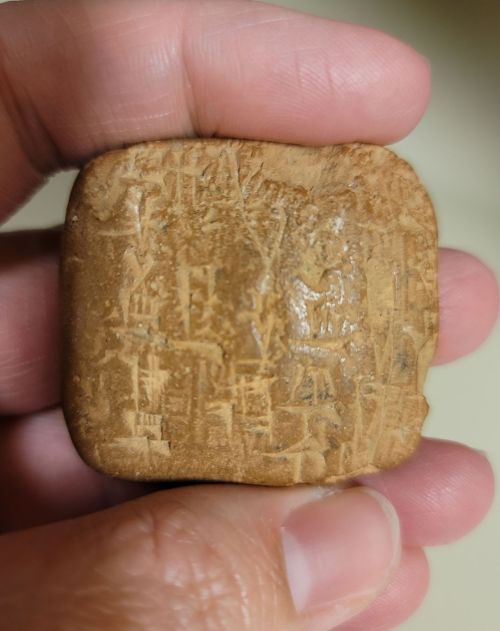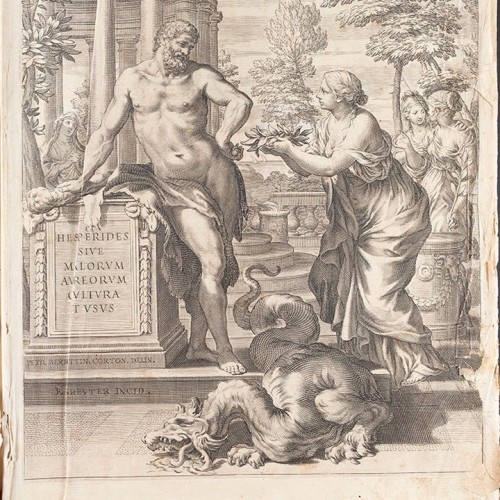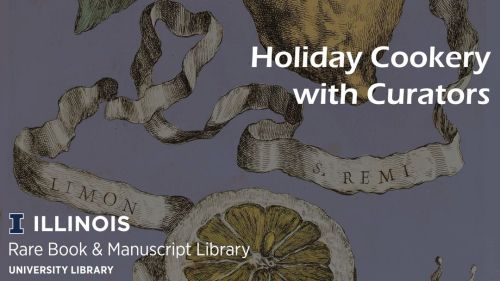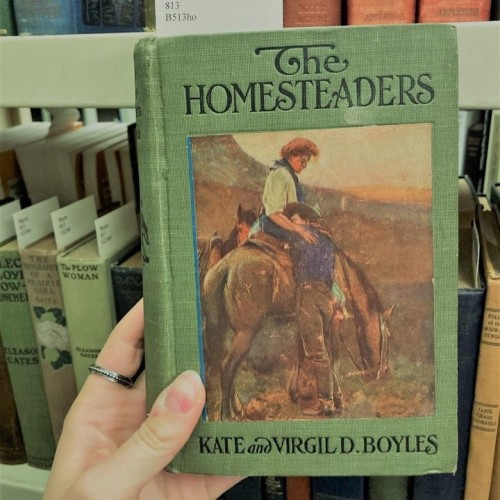#specialcollections
10 Things on the 10th: DAM, Graph Databases, the AP and Metadata
Here is the first installment of the monthly 10 things on the 10th:
- How to choose a digital asset management (DAM) system.
- Complete beginner’s guide to information architecture.
- Getting started with graph databases.
- Controlled vocabulary for DAM.
- Coloring book pages from special collections #ColorOurCollections.
- From Ralph Windsor: the stages of DAMconsciousness.
- The ASI (American Society for…
5 Things Thursday: DAM, Women in Tech, Metadata,
Here are five things:
- Curious about the best digital asset management software?
- Read about an inspiring woman in tech: Alice Merchant.
- MedNexus is the place to go when you are feeling like a hypochondriac.
- Can a company like Target fail because of metadata?
- Smithsonian Libraries receives digitizing hidden special collections award.
5 Things Thursday: Bowie, Search, Travel and Adventure
Here are 5 wonderful things:
- David Bowie loved to read. More on that here.
- A commercial traveler’s journals from the Penn Libraries special collections.
- Visual storytelling and digital asset management for adventure travel.
- Semantics is not search, but it can help.
- IPTC releases results of 2016 social media sites photo metadata test.
“Librarian reads the small print”:
A pop-up sampling of miniature books from the Evron Collins Collection
Diminutive size is the only feature uniting this throng of tiny tomes. Come and see the “Finger” New Testament; the “Kleinbuchs” distributed by the Winterhilfswerk; a sibling of the first book to travel to the moon; and many more!
Pop-Up Exhibit @ RBML
March 28 – April 8, 2022
Curated by Elissa B.G. Mullins
#specialcollections #rarebooks #minibook #exhibit #popupexhibition
https://www.instagram.com/p/Cb0eAESJFYE/?utm_medium=tumblr
Post link
Our workshop is currently full, BUT we encourage visitors to stop by tomorrow to see examples from our medieval collections and make souvenir buttons!
#specialcollections #rarebooks #medieval #medievalmanuscript #champaignurbana
https://www.instagram.com/p/Cb0EzDEL8iL/?utm_medium=tumblr
Post link
This beautiful artist book was created by @joannakrobson in 2011. “The Tempest 1932: a visual re-telling of the first play performed at the famous outdoor Minack Theatre, Cornwall” is a wordless retelling of The Tempest and is gorgeous! (IUB03270)
#specialcollections #rarebooks #artistbook #thetempest #shakespeare
https://www.instagram.com/p/Car7Baxuf7i/?utm_medium=tumblr
Post link
It’s Old Stuff Day! Take a moment to enjoy the oldest item in our collection - a cuneiform tablet from about 2,000 BCE. It was excavated from Umma in Mesopotamia and is written in Sumerian. (Pre-1650 MS 0218)
#specialcollections #rarebooks #cuneiform #mesopotamia #sumerian #oldstuffday
https://www.instagram.com/p/Canhe3qJFW0/?utm_medium=tumblr
Post link
Happy birthday to Charles F. Lummis (1859-1928)! Author, editor, librarian, leading Indian [what we now call Indigenous] rights advocate, and cross-continental adventurer, his Birch bark poems (Collins 0182) were written and printed during his college summers in the White Mountains of New Hampshire.
#specialcollections #rarebooks #poetry #happybirthday #birchbarkbooks
https://www.instagram.com/p/CakboDILz0Q/?utm_medium=tumblr
Post link
Check out the newest addition to our Digital Library - the Charles E. Mudie Papers, 1816-1897.
The Charles E. Mudie Digital Collection is comprised of correspondence, visual materials, and documents. This gathering of materials shed light on the management of Mudie’s Select Library, an innovative library that pioneered the concept of a circulating system operated by membership, as well as Mudie’s wide network of subscribers. The correspondence between Mudie, his family, and prominent 19th century literary English figures provides an ample view of the literary and publishing milieu during the Victorian era.
https://digital.library.illinois.edu/collections/3ae9f2b0-30b4-0138-7141-02d0d7bfd6e4-9
#specialcollections #rarebooks #archives #digitalcollections #mudie
https://www.instagram.com/p/CZKNXhJLOtn/?utm_medium=tumblr
Post link
We hope you’ll join us, either in-person OR virtually, today, January 24th, from 3-5 pm, for the opening of our Spring Exhibit in RBML!
RBML, in collaboration with the Geology Department, presents “In Search of Lost Time: The study of Earth history and chronology from the 18th to the 21st century”, on view from January 24-July 22, 2022. The related concepts of time, chronology, and history form the lens through which Earth scientists view, understand, and interpret a dynamic planet. This exhibit will explore how the chronology of the Earth was established, with a focus on six themes that gradually led to the consensus view that the Earth is roughly 4.55 billion years of age.
For those who would like to attend virtually, Professor of Geology and exhibit curator, William Guenthner, presents a virtual guided tour and live Q&A. Register at
http://ow.ly/2lsY50HBt9a
to receive the Zoom log-in info!
#specialcollections #rarebooks #geology #exhibit #fossils #uiuc
https://www.instagram.com/illinois_rbml/p/CZHlZUCpjMB/?utm_medium=tumblr
Post link
It’s Appreciate a Dragon Day! We appreciate this lovely specimen from Ferrari’s Hesperides…(1646)
Shelfmark Q. 634.23 F41h
#specialcollections #rarebooks #dragon #hesperides #appreciateadragonday
https://www.instagram.com/p/CYzRE5eJ6OL/?utm_medium=tumblr
Post link
Join the RBML curators as they recreate historical recipes from the collection in their home kitchen!
#specialcollections #rarebooks #cooking #recipe #historicalrecipes #lemons
https://www.instagram.com/p/CXRkiQgpWaT/?utm_medium=tumblr
Post link
In honor of the winter weather, here are two books with covers that just say *brrr!* Both are from the Nina Baym Collection and are currently uncatalogued, so who knows what stories lie within?!
#PublishersBindingThursdays #specialcollections #rarebooks
https://www.instagram.com/p/CXRjOm4pmNu/?utm_medium=tumblr
Post link
“A Man of Two Countries” by Alice Harriman, from our Nina Baym Western Women Writers Collection is unique in the fact that it is not only written by a woman, but also published by the author’s own publishing company!
#specialcollections #rarebooks #publishersbindingthursday
https://www.instagram.com/p/CWJFjsOJaYy/?utm_medium=tumblr
Post link
This is an example of one of the most detailed publishers’ binding covers in the Nina Baym Western Women Writers Collection. The story is a classic example of the Western fiction in the Baym Collection.
#publishersbindingthursday #specialcollections #rarebooks
https://www.instagram.com/p/CVk62U8p9FQ/?utm_medium=tumblr
Post link
Shiny! RBML recently acquired a facsimile of the Oxford Menologion – a mid-14th century prayerbook possibly from Thessaloniki. The text has a pictorial calendar of the saints for the full year, which are illustrated in 103 full-page miniatures and 2 texts in Greek.
Call number: IUQ05026
#specialcollections #rarebooks #byzantine #greek #medievalmanuscript #facsimile
https://www.instagram.com/p/CVN0XdkrXsM/?utm_medium=tumblr
Post link
Check out our most recent blog post about the Schamp-Levin Collection, which contains the papers of Mable Schamp and her second husband, Meyer Levin. Mable Hall Schamp (1912-1951) grew up in poverty but earned a doctorate in chemistry from the University of Chicago in 1936, served as a volunteer in the Spanish Civil War, worked on male contraceptives, battled mental illness, and became the first female professor at the City College of New York’s Chemistry Department.
Link to blog post: http://wordpress.library.illinois.edu/rbx/2021/07/28/collection-highlights-the-story-of-mable-schamp-1912-1951/
Photo: Mable in Spain, Schamp-Levin Collection, MSS00057
#specialcollections #rarebooks #universityofchicago #citycollegeofnewyork #chemistry #womeninscience #womeninstem
https://www.instagram.com/p/CR3_FWjMRos/?utm_medium=tumblr
Post link
OTD in 54 CE, Emperor Claudius of Rome was allegedly poisoned by his adopted son and successor, Nero. Just in case, read up on methods of detection with “A treatise on adulterations of food and culinary poisons: exhibiting the fraudulent sophistications of bread, beer, wine, spirituous liquors, tea, coffee, cream, confectionery, vinegar, mustard, pepper, cheese, olive oil, pickles and other articles employed in domestic economy; and methods of detecting them”. This treatise was written by Friedrich Christian Accum and published in 1820.
Call number: 614.31 AC21T
#specialcollections #rarebooks #rarebooksofinstagram #otd #rome #nero #poison
https://www.instagram.com/p/CU-ZeU6rjYi/?utm_medium=tumblr
Post link
Happy Preservation Week! (Part 5 :)
Hello again, and Happy Preservation Week, everyone!
This is the 5th and final installment of our Preservation Week 2021 blog series, if you missed Part 1,Part 2,Part 3orPart 4, feel free to check them out first!
In our previous post (Part 4), I described the preservation of a set of unexposed Daguerreotype plates and the original wooden box they were issued in. For those objects, I made an (admittedly) complex preservation enclosure that will keep everything safe in storage, but it might be a little confusing to the next person who opens the box. Sometimes it’s hard to make a simple, easy to use preservation enclosure… you find yourself making a series of “simple” decisions that snowball into something complex and baffling!
In this, our final Preservation Week post, I’ll discuss a preservation enclosure that needed to fulfill a lot of different requirements, and the object that it houses is one which I never expected to find in a library! This object is part of the Outpunk Archive at NYU, which contains materials from 1989-1998 relating to Outpunk (both the zine and the queercore music label). While most of the collection consists of papers, photographs, and music recordings, there are also several T-shirts and …a skateboard!

Apparently, a member of the Riot Grrrl movement owned and adorned this skateboard: one half of the top of the board is spray painted white, and the words “FIGHT HOMOPHOBIA” are spray painted in orange on the other half (Photo 1). Lots of stickers, self-adhesive labels and zine-style xeroxed drawings are pasted to the bottom surface of the board (Photo 2). This person probably lived in San Francisco in the late 1990’s, because one drawing asserts that “The Mission Bay Project SUCKS!” (Photo 3).

A few of the papers are bright yellow, orange or green, and these glow brightly under UV, suggesting that the papers contain daylight fluorescent pigments (Photo 4). These pigments look unusually bright in sunlight because they absorb UV radiation and reflect it back to the eye as visible light. While we were examining the top of the board under UV, we found yet another message hidden beneath the white paint… at one point, the owner of this skateboard believed that “FASHION IS A SCAM”, but she later decided to paint over this message (Photos 5-6).
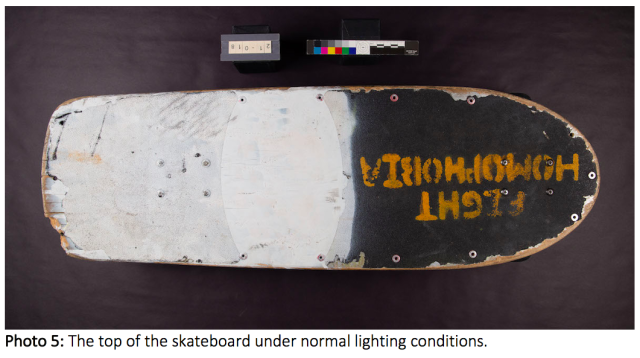

So… why the heck was this skateboard in the conservation lab? Well, it’s a lot bulkier than the average library book, and since the wheels work perfectly we couldn’t just leave it on a shelf! We needed to give the skateboard a preservation enclosure to keep it from rolling around in the stacks, or being mistaken for an NYU student’s property. Most of all, we wanted to give the skateboard a preservation enclosure to prevent its minor damage from getting worse: the plywood board is cracked and splintering at one corner, the sandpapery grip tape is flaking off around the edges, and most of the stickers and drawings are torn and/or curling. We briefly discussed whether we should perform a little conservation work to stabilize these parts of the board; in the end, we decided that we didn’t want to obscure evidence of the skateboard’s use, and everything was stable enough to withstand gentle handling. …Some may be thinking, “COME ON, it’s a skateboard! This is ridiculous.” To that I say, it’s part of an archive now! We have to treat it carefully, so it lasts a long time. :)
The library’s curators are interested in showing this skateboard during classes, and it’s possible that the object will be requested frequently in the Special Collections reading rooms. As you may recall, the main purpose of my Daguerreotype enclosure was to keep all of the components safe during storage and transit, but the skateboard’s enclosure needed to fulfill two additional requirements: it needed to be simple enough for anyone to unpack/repack easily, and because the skateboard is double-sided, the enclosure needed to function as a double-sided display mount. Under the supervision of Jessica Pace, Preventive Conservator, I created a simple preservation enclosure that would protect the skateboard and allow the curators to safely display either side.

We started by ordering a custom archival box with a drop-wall, which allows you to remove a bulky object more easily (Photo 7). Because the skateboard is a bit heavy and awkward, I also made a handling tray from cross-laminated sheets of archival corrugated cardboard. This tray (Photo 8) allows you to pull the skateboard out of the box, rather than lifting it. I also adhered strips of corrugated board to the bottom of the tray which adds a little more rigidity and allows for air-flow underneath when the tray is pulled out of the box. We decided it was best to store the skateboard wheels-down, so we had to find a way to prevent it from moving around in the box, or rolling off a table. Jessica thought it would be easiest to create bumpers on either side of the wheels, so I experimented with pieces of “Ethafoam” (low-density polyethylene foam, Photo 7). I cut four narrow strips of Ethafoam, and I wrapped them in a sheet of Tyvek fabric to prevent the foam from shedding bits of plastic inside the box. I used low-melt glue to adhere the foam to the handling tray, and I attached a pair of cotton pull-tabs to either side of the tray, to help people remove it from the box. The foam bumpers not only keep the skateboard stationary, but they can function as a display mount when someone wants to see the underside of the board. You can see the final enclosure in Photos 9-10, below:

Again, this was purely a preservation treatment, because the skateboard is in fairly good condition, despite minor damage. We chose not to repair this damage because it reflects the owner’s use of the skateboard, and the damage is not yet severe enough to threaten the object’s structural integrity. This simple preservation enclosure will prolong the life of the object and allow for conservation treatment in the future, if that becomes necessary. It may seem a little strange to treat this 20-year-old skateboard as though it were an ancient relic! I’ll admit, there were times when it felt a little absurd to apply my book and paper conservation skills to an object that (on the surface) looks like nothing special. If all goes well, however, the skateboard will survive for as long as the Daguerreotype plates or the 16th century parchment book… if so, the skateboard will teach future generations about late 20th century feminism and politics, queer history, punk rock, and alternative transportation!
Thank you so much for reading about our preservation activities at NYU Libraries this week, and thank you for supporting your local libraries!
Happy Preservation Week,
-Cat Stephens
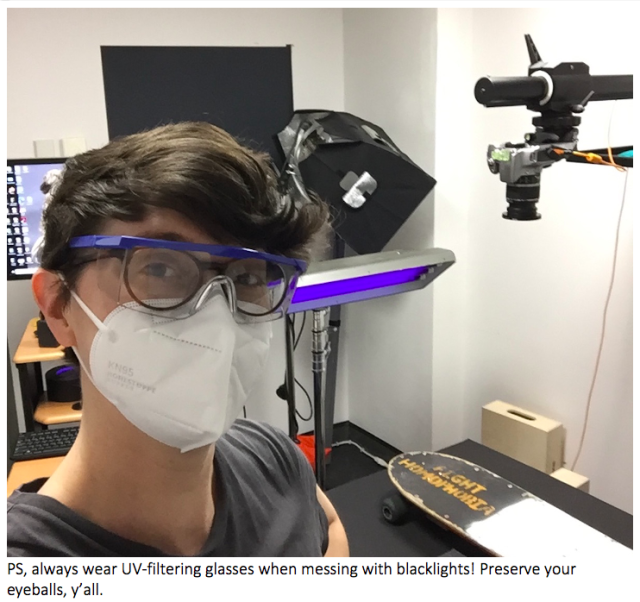
Happy Preservation Week! (Part 4 :)
Hello again, and Happy Preservation Week, everyone!
This is Part 4 of our Preservation Week 2021 blog series. If you missed Part 1,Part 2orPart 3, feel free to check them out first!
In Parts 2 & 3 I described two treatments that illustrate the ways in which conservation and preservation can be applied to old / extremely old library books. Today, I’ll focus mainly on preservation, and why we sometimes choose not to conserve an object.
Last November, I had the opportunity to preserve an unusual piece of photographic history: a small, mid-19th century wooden box containing 24 unexposed Daguerreotype plates (Photos 1-2). The Daguerreotype was invented by Louis Daguerre around 1839, and it was one of the first commercially viable processes that made photography and portraiture more accessible to the general public. Daguerreotypes were commonly produced until about 1860, when they were replaced with less expensive photographic processes, like the Ambrotype and the tintype.

Each Daguerreotype plate is made from a very thin sheet of copper, which is covered with an even thinner layer of highly polished silver (Photo 1). The wooden box that the plates were issued in originally contained 72 plates. The box’s longer walls have 36 vertical channels cut into them, allowing two plates to be inserted into each slot. After a Daguerreotype plate was sensitized, exposed, and developed with mercury fumes, the photograph was immediately packaged inside a small glass-fronted case. An example of a Daguerreotype in its original case (from the Metropolitan Museum of Art) is shown below, in Photo 3. These cases were meant to protect the delicate beads of mercury-silver amalgam that form the image, and, if a relatively tight seal was achieved around the plate, the glass could prevent air pollution from tarnishing the silver.
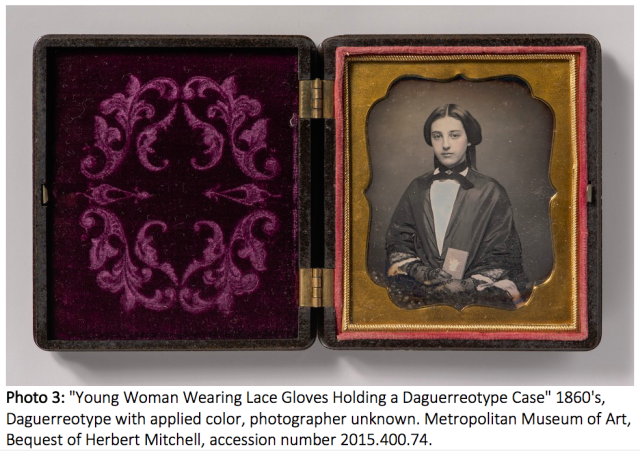
The unexposed Daguerreotype plates in Photo 1 are exhibiting varying levels of silver tarnish and copper corrosion, because they were stored in their original wooden box for a very long time. The center of each plate is less tarnished than the edges, probably because the center was less exposed to the air. The manufacturer’s box has also seen better days, unfortunately: its lid is missing, and its green paper label is water damaged, suggesting that the box fell victim to a leaking roof or a burst pipe. Worst of all, one of the longer walls is cracked down the middle, and one half of this wall is nearly detached from the floor of the box. Under the supervision of Laura McCann, Conservation Librarian, I designed a preservation enclosure for the Daguerreotype plates and their wooden box. Again, we decided to preserve these 25 objects in their current states, rather than trying to repair their damage.
Our decision to not perform conservation treatments on these objects was motivated by several factors: the tarnish on the silver plates tells an interesting story, and polishing the silver would not only change that story, it would necessitate the removal of some original material. And what would be accomplished by removing the tarnish, other than obscuring historical evidence? It’s unreasonable to expect 150 years old plates to look “new!” Similarly, the wooden box has a broken wall, but what would be accomplished by gluing it back together? The box still wouldn’t be strong enough to protect the Daguerreotype plates on its own, and, of course, its lid is still missing. Lastly, there are always more projects flowing into the lab, so why waste time by over-treating a stable object? Better to protect what already exists.

I began by enclosing each of the Daguerreotype plates in a 4-flap paper wrapper to protect the metal surfaces from abrasion and from further exposure to pollutants (Photos 4-5). The paper that I chose is unbuffered, and it passes the “PAT,” or Photographic Activity Test. This is important, because materials that are not PAT-passed might chemically interact with photographs and accelerate their degradation. I selected an archival storage container that was large enough to house both the plates and the wooden box, and I had to consider how everything would be stored inside it. Laura decided that it was safer to store the plates vertically (the same way they had been stored in their wooden box), so I created two small trays to hold them upright. I thought it would be best to divide the metal plates into two groups, which would balance their considerable weight inside the new enclosure… if one side of a box is much heavier than the other, an unsuspecting person might drop it!

The two trays (Photo 6) have a hollow, removable insert which keeps the plates upright in storage, but which can be removed for easier access to the plates. I wrapped the exterior of the wooden box in a piece of Mylar (thin, clear polyester film) and I inserted a piece of flexible foam (Volara) in the back compartment, to hold the broken wall upright (Photo 7). The Mylar will protect the delicate paper label from abrasion, and it supports the broken wall from the outside. Finally, I created a carrying tray with cotton straps, so that the wooden box can easily be lifted out of its archival box. The final enclosure (Photo 8) Looks a little intimidating when you first remove the lid, but its primary purpose is to protect the object from further damage in transit or storage:

This treatment was pure “preservation”; unlike the 19th century publisher’s bindings that I treated, no amount of repair would allow this object to safely return to the stacks all by itself. An enclosure was necessary because of the sheer number of loose components in this object, and because the lidless wooden box is no longer capable of protecting its 24 plates. This enclosure will keep everything together and will keep the objects safe and dust-free in storage, while still leaving the door open for future conservation work!
Thanks for reading, and stay tuned for tomorrow’s final Preservation Week 2021 blog post, where I’ll discuss the preservation of a Riot Grrrl’s skateboard (see photo below!)
-Cat Stephens


